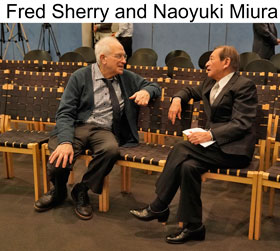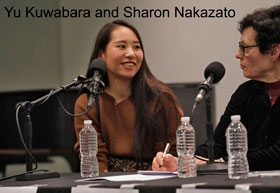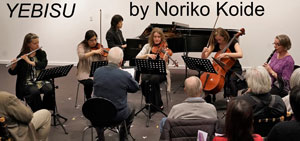
All photos by Ken Howard
The 45th Anniversary Season
Festival 2020 New York, Fifth Artist Residency
February 22nd: The Works of Noriko Koide
February 23rd: Identity, What Does it Matter? New Generations in Japan
Volvo Hall/Scandinavia House
58 Park Avenue at 38th Street
New York, NY 10016
Complete Program and Performer List
For its 45th Anniversary Season, Festival 2020 New York, and Fifth Artist Residency, Music From Japan invited composer Noriko Koide and musicologist Seiji Choki to New York for a series of concerts and educational events.
The Works of Noriko Koide
On February 22nd The Works of Noriko Koide included seven works from this composer’s eclectic oeuvre. The concert opened with Mistoffelees, named after the character in T.S. Elliot’s book Old Possum’s Book of Practical Cats, which became the basis for the popular musical Cats. The piece, for alto saxophone and percussion, is playful both in its instrumentation and the sounds these instruments conjured. The percussionist’s battery of instruments included not just concert percussion, but also kazoo, duck call, and many other small instruments. The sounds that come both from the percussion and the saxophone are very light-hearted, perhaps even cartoonish, but this levity does not detract from the depth of this compelling work. Tik-tik bird, a duo for cello and triangle (the triangle was performed by the composer herself), also calls for the two performers to sing. Equally playful as the prior piece, tik-tik bird recalls the humorous scene of a bird waking up the composer on a Sunday morning. Musically the piece vacillates between a percussive texture on the cello and triangle, and sing-song almost nursery rhyme-like passages in the voice. The finale was a harmonized song between the composer and the cellist, Meaghan Burke.
There is often a duality in Koide’s work between the conventional and the experimental, and Hone (Bone), for alto saxophone and koto is no exception. The performance delicately lilted between noisy textures and whimsical melodies, drawing especially upon the traditional melodic stylings of the koto. Like many of Koide’s pieces, Tipsy Steps for accordion and piano was inspired by something in the real world: in this case the work is supposed to be reminiscent of someone who has drank a little too much alcohol. The performance begins with a highly unconventional approach to both instruments—tapping them in places other than the keyboards to get a percussive sound. From there the piece seems to move from one scene to the next, meandering between different styles and motifs, perhaps like a drunk person might act.
Koide explains that A Holiday for Island Hoppers, for piccolo/toy whistle and koto was inspired by a lake designed by Japanese architect Junya Ishigami. The lake contains floating islands, and this short piece calls to mind the visitors playfully leaping from one island to the next across the body of water. The two final pieces on the program are part of Koide’s Treasure Ship Suite, which includes seven pieces corresponding to the Seven Gods of Fortune. Yebisu, for flute, violin, viola, cello, clarinet, and piano with conductor, is characterized by light-hearted melodies superimposed on, or punctuated by, percussive textures in the strings and piano. The music finally dissipated into airy and pizzicato sounds before a diminuendo into silence. Bishamon, for flute, percussion, clarinet, baritone saxophone and accordion, with conductor, was commissioned by Music From Japan. The performance for the festival was its world premiere. Perhaps the most dynamic piece on the program, Bishamon features large chordal stops in the wind instruments, with snare drum flourishes reminiscent of a drumline. As the piece progresses, the dynamics decrease as does the density of the chords. The wind instruments, which began by playing long tones, transition into percussive sounds. One unusual element in the piece is the use of hand trowels, which are suspended on cymbal stands in front of the performers. At the beginning, the performers rattle them, and at the end, they slowly walk off the stage carrying them as they rattle, leaving the percussionist alone on stage repeatedly playing rolls on the hi-hat.
Overall, the concert was a fabulous display of this interesting composer’s work. While each composition stood out on its own merits, there was a clear creative voice that permeated them all.
Following the concert there was an edifying forum, moderated by composer Brad Garton, including Noriko Koide, percussionist Sam Budish, and composers Takeo Hoshiya and Yu Kuwabara whose pieces were presented on the Sunday concert. After a warm introduction from Professor Garton, all of the panelists had an opportunity to reflect on the concert and speak about what was to come on the following day. The audience also had the opportunity to ask questions to the panelists.
Identity, what does it matter? New Generations in Japan
Seiji Choki, who curated the second night of the festival, opened the evening with an enlightening lecture on the history of the relationship of Japanese composers to Japanese identity. He separated the past century into five periods, identifying unique characteristics of each, and how composers redefined their relationship to European classical music throughout. Interesting musical examples from Toru Takemitsu, Minoru Miki, Misato Mochizuki and others were offered throughout the lecture. At the end of the talk he discussed the influence of sub-culture, pop culture, and internet culture on present-day Japanese composers. The presentation offered an apt introduction to the sounds that followed.
The concert began with a string trio by Yu Kuwabara called Three Voices, which is built around a series of downward glissandi, unfolding like a series of sighs. Oren Fader, who has been a fixture on MFJ concerts for years, performed the second piece, color song III for guitar solo, by Tomoko Fukui. He gave an introduction to the piece, describing Fukui’s idiosyncratic use of the guitar slide. Like the prior piece, this work also involves a series of glissandos, but rather than a gentle sigh, the music ricochets all over the range of the instrument in upwards and downwards percussive motion. Music for Four String Instruments by Takeo Hoshiya was performed by the Momenta String Quartet. Opting for more traditional string textures, single notes seemed to bounce around from player to player. A second string quartet, this one by Chiku Komiya, called For Formalistic Formal (SONATA?) Form For Four, followed. This strange-titled work relies on an equally strange conceit: the string players only play open strings for the duration of the piece. Relying only on this limited pitch material, based around fifths, Komiya keeps the audience engaged through elaborate rhythmic variations. Into the Offing for flute, clarinet, violin, cello and piano by Yuka Shibuya pensively moves forward through a series of glissandi, punctuated by chords within the piano and clarinet flourishes. Fred Sherry beautifully led the ensemble, conducting this piece as well as two others on Saturday. The music ebbs and flows, undulating in a series of waves. The final piece of the festival was Gewurzwolfie?! for string quartet by Jummei Suzuki. The composition is based off of a work by Mozart, using the canonical work as raw material to modify and transform throughout.
The 45th Anniversary Festival ended with an interesting forum moderated by critic John Rockwell, with curator Seiji Choki, composers Chiku Komiya and Yuka Shibuya, and music writer Michael Huebner. The discussions covered many topics including the increase in women composers in Japan, the role of gender, and the role of Japanese culture in the music presented.





















